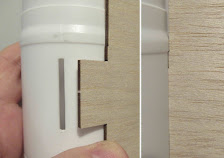Here's how I start the taper -
Get the leading edge width first, then work to the center line.
At the center balsa joint line, a piece of masking tape is set down the joint. This is just extra protection to prevent sanding too far down, over that balsa butt joint.
The width of the black ink line is not fully sanded to the final taper. Leave a little width. You'll probably end up sanding that width down a bit more when shaping to the center line.
The center tabbed layer shows thru when sanding. It is also used to judge the consistency of the taper.
Another view showing the initial sanding down of the sides.
Again, notice the masking tape down the outside two piece balsa butt joint line.
Notice the masking tape edge is starting to be sanded. It's surprising how well the paper tape protects the high point of the fin - to a point. Be careful though, you can sand through the tape.
TRIVIA: I remember this technique of taping the fin from the old Estes Honest John kit, #K-27.
Here's a finished taper fin after the tape is removed.
It's hard to see the leading edge in this picture but there is still a thin consistent width black ink line.
The remaining ink is sanded off using 220 grit on a block. The leading and trailing edges are then rounded off using 400 grit.
The lower fins have a very slight taper from the root edge out to the outside edge.
Look at the Fin Alignment on page 7 of the instructions -
The middle fins have a more pronounced taper from the root edge to the outside edge. Sand that second stage fin taper before doing the diamond shaping.


















































